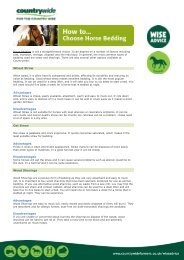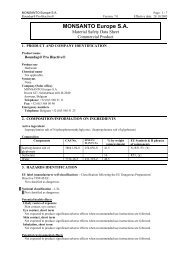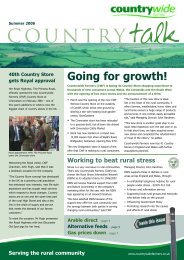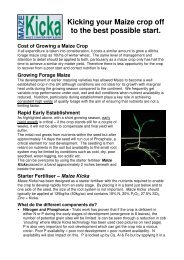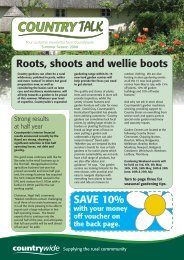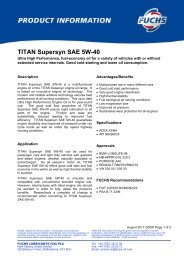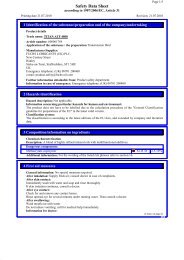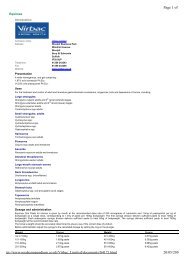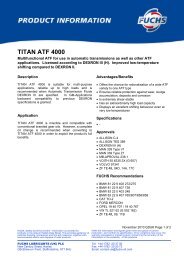How to Make Good Quality Silage - Countrywide Farmers
How to Make Good Quality Silage - Countrywide Farmers
How to Make Good Quality Silage - Countrywide Farmers
You also want an ePaper? Increase the reach of your titles
YUMPU automatically turns print PDFs into web optimized ePapers that Google loves.
Grass is the cheapest source of feed for any lives<strong>to</strong>ck enterprise and effective utilisation ofgrass and its management is the key <strong>to</strong> getting the most of your grassland. Ruminant animalsdepend on grass as a major source of energy and protein as well as vitamins and minerals.The <strong>to</strong>tal energy value of food eaten by an animal is its gross energy or GE. Some of thisenergy is passed straight out of the animal in the faeces and the remainder is processed by theanimal in the digestion process and is hence called Digestible Energy (DE). This is then furtherbroken down by the methane making process in the rumen and also through urine. Theremaining energy is termed ME or metabolisable energy and this is what is used <strong>to</strong> measurefeed values. A good quality hay has a ME level of 9.0 megajoules of ME per kilogram of drymatter. This compares <strong>to</strong> 10.5 of grazing s<strong>to</strong>ck on grass.The way <strong>to</strong> make maximum return from grass is by:<strong>Good</strong> grassland management for grazing or conservationApplying the correct balance of nutrientsApplying fertiliser at the right timeThis guide outlines the tips <strong>to</strong> ensure good silage making so that winter forage supplies can bemaximized.What is silage?The process of ensilage consists of preserving green forage crops under acidic conditionsensuring they remain in a succulent and appetising state. Grass is cut and heaped <strong>to</strong>getherwhere it respires until all of the oxygen in it is exhausted. Bacteria will then control the processof fermentation silage has <strong>to</strong> go through so that it is in a preserved state. These bacteria whichare present on the crop fall in<strong>to</strong> two categories desirable and undesirable.The desirable bacteria are the ones which can convert carbohydrate in<strong>to</strong> lactic acid and areusually of the strains lac<strong>to</strong>bacillus and strep<strong>to</strong>coccus. They are anaerobic bacteria and theyneed <strong>to</strong> be evenly distributed throughout the crop.This is encouraged by chopping of the grass and the rapid consolidation of the exclusion of air.Lactic acid is a strong organic acid and its rapid production in the ensiled grass leads <strong>to</strong> a lowpH and conditions which will inhibit the lactic acid producing bacteria and all other bacteria inaddition. This is known as pickling and the pH at which this develops depends on the moisturecontent of the grass. The wetter the grass is the lower the pH needs <strong>to</strong> be and the greateramount of lactic acid that needs <strong>to</strong> be produced. Wet silage of approximately 20% dry matterwill require a pH of around 4.0 for the silage <strong>to</strong> be stable but grass at 30% dry matter will needa pH of 4.6–4.8.
What makes good silage?<strong>Good</strong> silage is light brown in colour, has a sharp tasteand little smell as its lactic acid content is right. It isvery stable and can be kept for years if requiredprovided that oxygen is restricted from the material. Forthe best fermentation <strong>to</strong> occur the crop should have ahigh carbohydrate content and a low moisture content.Cutting should take place when their carbohydrate(soluble sugar) content is high and when the grass canbe wilted swiftly. Sugar content should be at least 3% atcutting and grass should be wilted at a moisture conten<strong>to</strong>f 80% down <strong>to</strong> one of 70-75%.Expected yields of silage can vary from 6–18 <strong>to</strong>nnes perhectare of silage fed depending on the time of year, drymatter, variety and fermentation success.What else should I consider?Undesirable bacteria should be reduced where possible. These undesirable bacteria are:1. Obligate anaerobes of the clostridium species that can ferment carbohydrate and lacticacid <strong>to</strong> form butyric acid.2. Aerobic species of bacteria that can oxidise carbohydrate <strong>to</strong> form carbon dioxide andwater.3. Clostridium sporogenes which can break down amino acids <strong>to</strong> produce ammonia andamines, some of which are <strong>to</strong>xic <strong>to</strong> animals.Butyric silage will have a rancid smell and be of a dark, olive green appearance. This isunpalatable <strong>to</strong> all s<strong>to</strong>ck. It is also less stable as it has a higher level of lactic acid which meansits life is limited <strong>to</strong> a few months.The clostridial activity in silage should be reduced by:Reducing the moisture level of the crop as this will ensure less acid is needed <strong>to</strong>complete the ensiling processEnsuring adequate carbohydrate is present for the lactic acid bacteria. If this is not thecase apply an acid <strong>to</strong> assist this process of lowering the pH level.Avoiding soil contamination within the grass when either cut or picked up by machine.The intrusion of air in the fermentation process will delay or even prevent the correct pH levelbeing achieved. This will lead <strong>to</strong> an excessive amount of carbohydrate being used which willlower the feed value of the silage. Intrusion of air after the silage has reached a stable conditionwill result in a further loss of condition throughsecondary respiration and reduced carbohydrates. This will shorten the life of the product. Thiscan also result if a silo is opened or the face of the clamp is <strong>to</strong>o large for the amount of silagebeing removed by s<strong>to</strong>ck on a regular basis.<strong>Silage</strong> making can result in a considerable loss of original grass through the wilting,fermentation and feeding period. Field losses can amount <strong>to</strong> 0–10% of the dry matter contentand are usually caused by the degree of wilting in the field. Losses in the fermentation processare also experienced and these can be between 10 and 20% of dry matter content. There isalso visible waste from clamps and silos from their sides and <strong>to</strong>ps and this can be between 5and 15% of dry matter.
It is therefore expected on an excellent silage system <strong>to</strong> have only 80% of the dry matter of thegrass <strong>to</strong> reach the end silage product and sometimes this figure on poorer systems can be aslow as 65-70%.Additives are available <strong>to</strong> help maximise the quality of silage produced. There are three maintypes of additives:1. Sugars/carbohydrates – by adding extra sugar or molasses the crop is more able <strong>to</strong>produce lactic acid. Some additives contain materials <strong>to</strong> stimulate the lac<strong>to</strong>bacillibacteria.2. Acids – formic and sulphuric acid are applied at a rate of between 3–5 litres per <strong>to</strong>nneas the grass is picked up in the field. This reduces the quantity of lactic acid needed <strong>to</strong>reach a stable pH.3. Preservatives – these suppress chemical reactions and allow the fermentation processmore easily. These are usually within acid additives.<strong>How</strong> should I s<strong>to</strong>re my silage?Traditional s<strong>to</strong>rage methods on farms have been silos, <strong>to</strong>wers and clamps. <strong>How</strong>ever bales arenow becoming increasingly popular, due <strong>to</strong> ease of transport and also mobility of feeding. Balesare wrapped in polythene material <strong>to</strong> ensile them and can be of three colours. Black is the mostcommon colour but white and green are available.White promotes a lower fermentation temperature as it reflects the sun and green is oftendemanded for its aesthetic impact particularly in national parks. Care should be taken whenmoving bales <strong>to</strong> avoid punctures as this will start the secondary fermentation process with anyholes or tears being repaired. Stacks of bales should also be routinely inspected for bird andvermin damage and nets should ideally be placed over them.DisclaimerThe information in this publication is meant as a brief and general guide only and is not intended <strong>to</strong> bespecific advice, or an exhaustive treatment of the subject. <strong>Countrywide</strong> <strong>Farmers</strong> plc advises that youshould always consult a professional, as it is possible that the information in this guide may not relate <strong>to</strong>your particular situation. Whilst <strong>Countrywide</strong> <strong>Farmers</strong> plc endeavours <strong>to</strong> keep this publication up <strong>to</strong> dateand correct we make no representations or warranties of any kind, express or implied, about thecompleteness, accuracy, reliability or suitability of the guide. Any decisions based on information containedin the guide are the reader’s sole responsibility. To the fullest extent permitted by applicable law<strong>Countrywide</strong> <strong>Farmers</strong> plc accepts no responsibility for any loss or damage as a result of any reliance placedupon information given in this guide by the reader or anyone <strong>to</strong> who such information is communicated.



